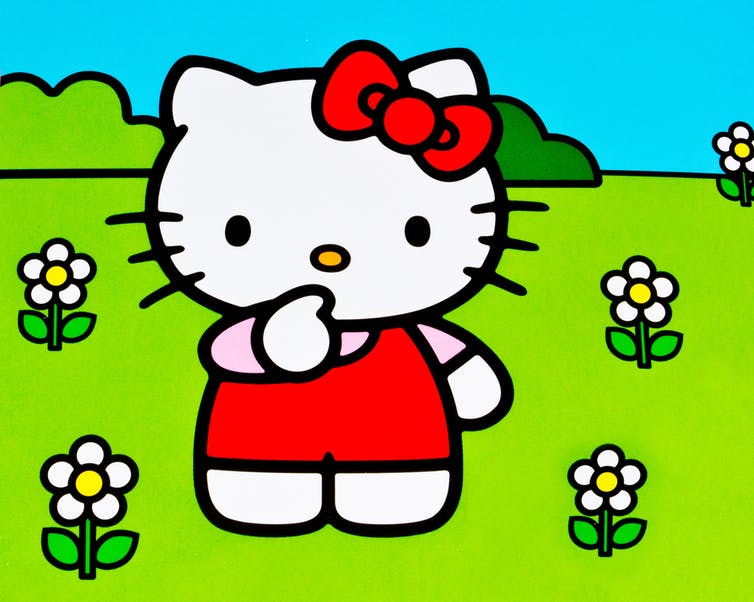
This is a true story. One Saturday night, I was sitting with a friend in a trendy downtown bar, when two grown women casually strolled past in ruffled dresses, bonnets and parasols, wheeling matching baby carriages. Out of these peeked little poodles wearing complementary pastel baby clothes. We were of course in Japan, but still, what on earth was going on?
So, what is kawaii and why here and why now? As the Japanese word for cute, kawaii has connotations of shyness, embarrassment, vulnerability, darlingness and lovability. Think babies and small fluffy creatures. In many cases, it is a signifier for innocence, youth, charm, openness and naturalness, while its darker aspects have led it to be rather brutally applied to frailty and even physical handicap as a marker of adorability. You may not have noticed, but look carefully and Hello Kitty has no mouth.
Hello Kitty: mouthless, voiceless. Shutterstock
As kawaii suggests, cute culture first originated in Japan, emerging out of the student protests of the late-1960s. Rebelling against authority, Japanese university students refused to go to lectures, reading children’s comics (manga) in protest against prescribed academic knowledge.
Get your news from people who know what they’re talking about.
Sign up for newsletter
As the economy progressed through the 1970s and 1980s, so did consumer subcultures – and cute as a style began to be expressed through childish handwriting, speech, dress, products, shops, cafes and food. Meanwhile, as Japanese women became more visible at work, so the “burikko” or childlike woman emerged, portraying an innocence and adorability that alleviated the threat of female emancipation, increasing her appeal as a potential marriage partner.
The Lost Decade
By the 1990s, Japan’s period of economic crisis was well underway, and many Japanese subcultures fled into the international market. Banks and commercial airlines began to explore cute as a strategy to increase their appeal, and cultural forms followed in the footsteps of the once invincible Japanese corporate machine, spreading the soft power of Japanese modernity.
Where Nissan, Mitsubishi, Sony and Nintendo had carved a path, so trod Japanese anime, film and music. The 1990s also saw the refreshing of the ultimate kawaii brand, Hello Kitty, expanded to include products aimed at teens and adults rather than pre-adolescent girls.
Eva Air: taking to the skies with Hello Kitty. Masakatsu Ukon via Flickr, CC BY-SA
As part of the 1990s wider spread of Japanese culture, kawaii is undoubtedly indebted. However, its persistence well into the 21st century shows that something else is now afoot. Cute culture is everywhere and claimed by everyone, regardless of age, gender and nationality. More than the fuzzy dice hanging from the rear-view mirror, it is the collectable branded official merchandise of cartoons and comics, the endless animations and superhero films, the doll-like dresses of “Lolita” fashion and the phone-clutching clusters of Pokemon Go players.
Importantly, it does not seem to rely on Japan, but has become homegrown in multiple locations, with global participants consuming and contributing in equal measure. At first glance, it appears these childlike adults, like the proverbial Peter Pan, don’t want to grow up – but how convenient for business that they can whip consumers into a frenzy, reducing grown men and women into childish, irrational desire. Cute culture is capitalism disguised, repackaged and covered in glitter.
Pokemon Go, on the road. Shutterstock
A force for good?
Looking at the adult landscape, with its pressures of debt, competition and responsibility, it is no wonder that people want to escape into the infinite time, space and promise of childhood. Cute becomes a way of resisting the adult world. It’s not just a means of escape and denial, but also a way to fight back against the curtailment of possibility. Japanese women used cute culture as a denial of female sexuality and all the subjugation it implied. Meanwhile in the West, cute becomes a foil for millennials against the diminishing of privileges that mark the end of the late-20th century as a Golden Age.
So, is cute culture good or bad? Perhaps both and neither. A legitimate subcultural form and a soporific soother, it is a form of resistance and a capitalist pacification. Symptom and cure, it is ultimate allowance and refusal. Childhood means the luxury of not growing up, but also denial of adulthood and the refusal of responsibility. But while kawaii may seem like a closing of one door, held in its small furled fist is a key that opens another. To be simultaneously adult and child means to straddle both worlds, a symbol of resistance and boundless possibility.












